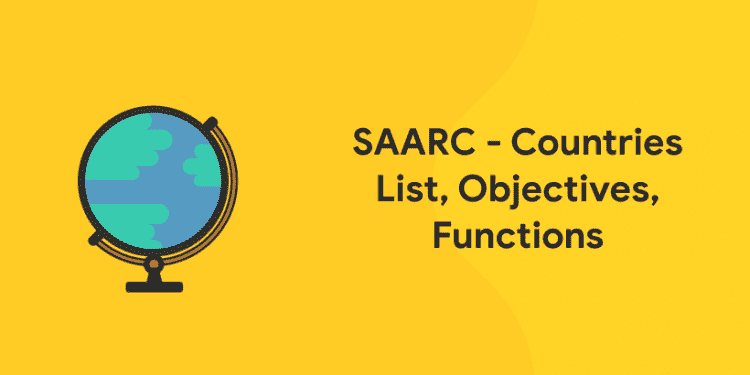Table of Contents
SAARC is the South Asian Association for Regional Cooperation is the regional intergovernmental organization and geopolitical union of states in South Asia. It came into effect on December 8, 1985. In this article, we will break down the SAARC and list out the member countries, its objectives and functions. Read on to find out more.
Attempt free GK Mock Test! Download Entri App Today
All About SAARC
In this segment, we will discuss SAARC and its various aspects and functions. It will serve as a comprehensive guide to understanding SAARC. We will list out the Countries List, Objectives and Functions.
SAARC Countries List
| Countries | Status |
| India | Member State |
| Pakistan | Member State |
| Sri Lanka | Member State |
| Bangladesh | Member State |
| Afghanistan | Member State |
| Nepal | Member State |
| Maldives | Member State |
| Bhutan | Member State |
| United States of America | Observer |
| European Union | Observer |
| Australia | Observer |
| Iran | Observer |
| Japan | Observer |
| China | Observer |
| Republic of Korea | Observer |
| Mauritius | Observer |
| Myanmar | Observer |
SAARC Objectives
The main objectives of SAARC are to promote welfare of people of South Asia, accelerate economic growth and increase collaboration and mutual assistance in economic, social, culture, technology and scientific fields. SAARC has carved out several regional Conventions, Agreement, Protocols and Mechanisms for realizing these objectives.
- Promote the welfare of the peoples of South Asia and improve their quality of life;
- Accelerate economic growth, social progress and cultural development in the region by providing all individuals the opportunity to live in dignity and realise their full potential;
iii. Promote and strengthen collective self-reliance among the countries of South Asia;
- Contribute to mutual trust, understanding and appreciation of one another’s problems;
- Promote active collaboration and mutual assistance in the economic, social, cultural, technical and scientific fields;
- Strengthen co-operation with other developing countries;
vii. Strengthen co-operation among themselves in international forms on matters of common interest; and
viii. Cooperate with international and regional organisation with similar aims and purposes.
Areas of Cooperation
Information and Poverty Alleviation
Agriculture and Rural Development
Environment, Natural Disasters and Biotechnology
Energy, Transport, Science and Technology
Education, Security and Culture and Others
Human Resource Development and Tourism
Economic, Trade and Finance
Social Affairs
SAARC Functions
The SAARC seeks to promote the welfare of the peoples of South Asia, strengthen collective self-reliance, promote active collaboration and mutual assistance in various fields, and cooperate with international and regional organizations.
Principal Organs
Meetings of Heads of State or Government
Meetings are held at the Summit level, usually on an annual basis. To date, 20 Summits have convened: Dhaka (1985), Bangalore (1986), Kathmandu (1987), Islamabad (1988), Malé (1990), Colombo (1991), Dhaka (1993), New Delhi (1995), Malé (1997), Colombo (1998), Kathmandu (2002), Islamabad (2004), Dhaka (2005), New Delhi (2007), Thimphu (2010), Addu City (2011), Kathmandu (2014), Islamabad (2016) and Islamabad (2020).
Council of Ministers
The Council, comprising the Foreign Ministers of Member States, generally meets twice a year. The Council may also meet in extraordinary circumstances by agreement of Member States.
Standing Committee of Foreign Secretaries
The Committee provides overall monitoring and coordination, determines priorities, mobilizes resources, and approves projects and financing. The Standing Committee is assisted by a Programming Committee, an ad hoc body, comprising senior officials, to scrutinize the Secretariat Budget, finalize the Calendar of Activities, and take up any other matter assigned to it by the Standing Committee.
Secretariat
The SAARC Secretariat was established in Kathmandu on 16 January 1987. Its role is to coordinate and monitor the implementation of SAARC activities, service the meetings of the association and serve as the channel of communication between SAARC and other international organizations.
The Secretariat comprises the secretary-general, seven directors, and the general services staff. The secretary-general is appointed by the Council of Ministers on the principle of rotation, for a non-renewable tenure of three years.
Get Access to Weekly Current Affairs on the Entri App
Conclusion
1: Who was the first woman President of India?
This was the comprehensive guide to SAARC. In this article, you have learned about SAARC, its functions, objectives and the List of Countries involved. This will be useful in various exams. To get more of such knowledge and help for exams, download the Entri App. You can gain access to Online Classes, Video Lectures, Current Affairs and the best of all; Mock Tests. Click here to learn how mock tests can improve your scores. This is a good time to prepare. Good Luck.













